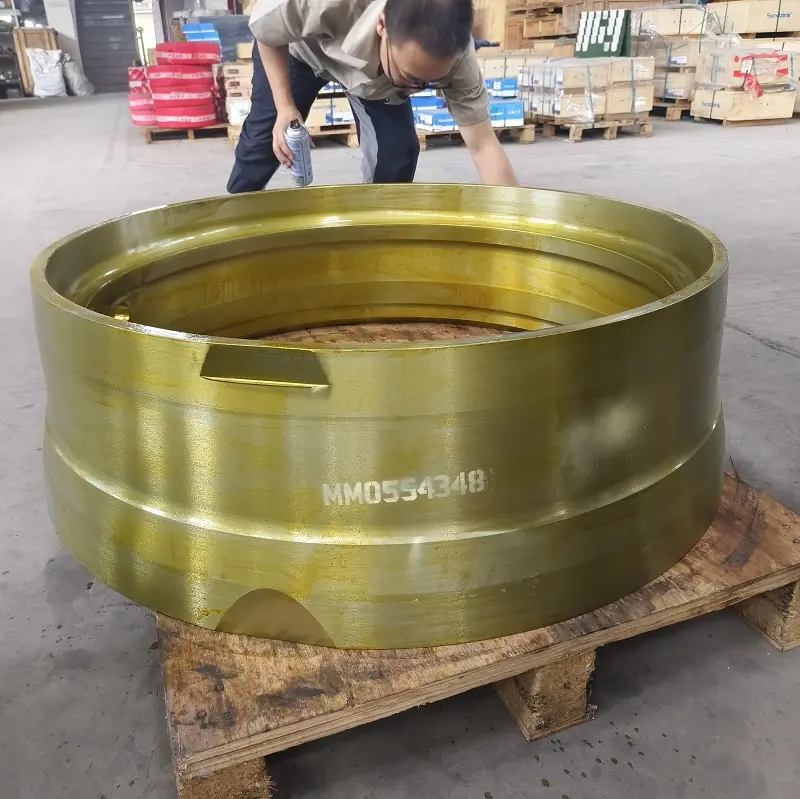Among the core components of the crusher, the middle cone plays a crucial role in crushing and is bound to wear out due to long-term contact with the material. When the middle cone shows signs of wear, timely adoption of appropriate repair techniques can not only restore the performance of the equipment but also avoid additional expenses caused by replacing new components. Understanding different repair processes and their corresponding cost structures can help make more reasonable maintenance decisions.
Common repair processes first include surfacing repair. This method evenly covers the worn surface of the cone with wear-resistant materials through dedicated welding equipment, fills the depressions and notches formed by wear, and then restores the original shape after grinding treatment. The advantage of surfacing repair lies in its ability to directly replenish materials at the worn area, which is particularly suitable for cases where local wear is severe. When operating, it is necessary to control the welding temperature to avoid deformation of the cone due to high temperature, which may affect the subsequent assembly accuracy. After completion, the surface still needs to be leveled to ensure that the fit clearance with other components meets the requirements.
Another commonly used process is thermal spray repair. This process melts wear-resistant powder or wire through a high-temperature heat source and then sprays the molten droplets onto the worn surface of the cone with a high-speed gas flow, forming a dense wear-resistant coating. Thermal spray repair has a relatively small thermal impact on the cone itself, is less likely to cause deformation, and is suitable for components with high precision requirements. The thickness of the coating can be flexibly adjusted according to the degree of wear, and a variety of wear-resistant materials can be selected to adapt to different crushing environments. However, the bonding strength between the coating and the substrate needs to be strictly controlled to prevent peeling during use.
For intermediate cones with relatively light wear, mechanical processing can sometimes be adopted for repair. The worn surface is machined by a lathe or milling machine to remove the worn part on the surface layer, restoring the cone to its standard size. This method is simple to operate and has high processing accuracy, but it is only suitable for situations with small wear, as excessive cutting will reduce the wall thickness of the cone and affect the overall strength. After mechanical processing, it is usually necessary to carry out surface hardening treatment to extend the service life after repair.
The composition of repair costs needs to be considered from multiple perspectives. Material cost is the foundation. The prices of materials used in different processes vary. The expenses of special materials such as wear-resistant welding rods and spray powder will directly affect the total cost. Labor costs cannot be ignored either. Complex repair processes require skilled operators. The longer the working hours, the higher the labor expenses.
The cost of equipment usage also needs to be taken into account. Surfacing requires dedicated welding machines, while thermal spraying relies on spraying equipment. The depreciation and energy consumption of these devices will increase the overall expenditure for repair. In addition, the post-repair processing steps will also incur costs, such as subsequent grinding, heat treatment and other procedures. Although the individual costs are not high, the accumulated costs will also affect the total cost.
There is a certain balance between the choice of restoration techniques and the cost. The material cost of surfacing repair is relatively low, but it has high technical requirements for operators and labor costs may increase. The initial investment in thermal spraying equipment is relatively large, but it is more efficient in dealing with large-scale wear and tear, and may be more economical in the long run. The single cost of mechanical processing is relatively low, but its application range is limited. If the wear is severe, it cannot be adopted.
Hidden costs also need to be taken into account. The service life of the repaired middle cone directly affects the overall cost. If the repair process is not properly selected, it may lead to re-wear in the short term and increase the expenditure on repeated maintenance. Therefore, choosing a repair process suitable for the equipment’s working conditions and ensuring the repair quality can fundamentally control costs.
The repair of the middle cone needs to be comprehensively judged in combination with the degree of wear, the usage environment of the equipment and the actual budget. Each repair process has its applicable scenarios and cost characteristics, and there is no absolute superiority or inferiority among them. By understanding the operational characteristics and cost structure of different processes, more targeted repair plans can be formulated, ensuring the performance of the equipment while achieving reasonable control of maintenance costs. Timely and appropriate repair and treatment can not only extend the service life of the middle cone but also keep the crusher in a stable operating state.
Post time: Sep-22-2025

